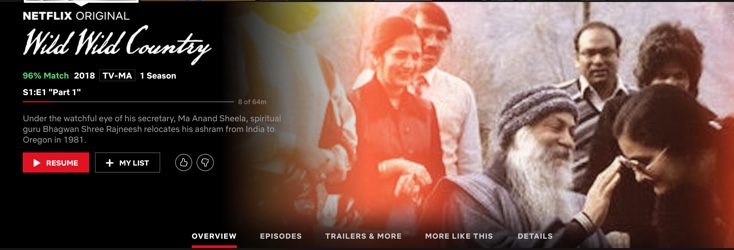The Illusion that Oregon’s Rajneeshpuram Was Built on

Rajneeshpuram, the communal city that lasted four years in central Oregon, has made it to Netflix and Saturday Night Live. Its rise and fall between 1981 and 1985 is a dramatic and literally colorful story, dominated by the larger than life figures of Bhagwan Shree Rajneesh and his chief fixer Ma Anand, by the spectacle of Bhagwan being driven in one of his dozens of Rolls-Royces past throngs of acolytes dressed in the sunrise colors of orange, red, and purple Sheela, by murder plots and bioterrorism.
As a historian of the American West, however, I want to take a step back from the drama to argue that Rajneeshpuram’s big problem was that it was built a century and a half too late. The Rajneeshees arrived in Oregon acting as if they had arrived on an open frontier where they could do what they wanted, and instead found themselves constrained by regulations and bureaucracies. In effect, they expected to reenact the mid-nineteenth century West in the very different environment of the late twentieth century.
Consider an analogy. In the 1840s and 1850s, a group of religious refugees left the eastern United States for the isolated and sparsely populated Great Basin. They built single-religion towns, developed irrigated agriculture, and tried to extend political and economic control beyond their core settlements. Like the Mormons, the Rajneeshees considered themselves refugees (Bhagwan and Sheela had left India under growing government pressure) who were arriving in an empty land. They worked hard to restore overgrazed ranchland. They expanded beyond their 64,000 acre ranch property by taking control of the neighboring town of Antelope and trying to drive out its residents, and they schemed to take political control of Wasco County, in which Rajneeshpuram was located.
Rajneeshees were utopians, but they were also settler colonialists who expected to displace earlier residents of a territory and take it over for themselves. When Sheela said that “stagnant, dilapidated little towns like Antelope [are] places where indolent old people go to mark time until they die,” her words echoed nineteenth century American ideas about "the vanishing Indian" that justified racial displacement. After the collapse at least some Rajneeshees acknowledged their sense of entitlement. As one confessed: “I guess that’s part of our arrogance … that we believed in, or bought into, about being better than, the rest of Oregon or humanity or whatever.”
The frontier utopia, the blossoming desert, settler colonialism are all stories about white pioneering and homesteading. They are about the power and opportunity to create something new in an unconstrained environment. Rajneesh leaders looked at Oregon and thought they saw the same unregulated landscape that had greeted Oregon Trail pioneers. More specifically, Sheela had not bothered to thoroughly check out zoning restrictions before buying the ranch, and quickly came crosswise with the land use advocacy group, 1000 Friends of Oregon.
In fact, a twentieth century counter narrative played out. Eastern Oregon may have looked empty to sannyasins(the disciples), with few people and skimpy economic activity, but it was institutionally full, layered with regulations enforced by public bureaucracies. The history of the twentieth century West is inextricably bound up with the extension and articulation of government power through resource agencies, infrastructure investment, the defense establishment, immigration control, trade policy, etc. There would have been no Rajneeshpuram without federal hydropower dams and the Bonneville Power Administration, not to mention federal air traffic controllers to help Bhagwan get to Oregon and state and federal money to smooth the roads for Bhagwan’s afternoon drives.
Rajneeshpuram collapsed in large part because its leaders ran up against regulatory systems—particularly relating to land use and to elections—that limited their options. They might have modified their related goals of creating a permanent city and an expensive destination resort. Instead, they challenged the regulations with litigation, with efforts to wield political influence, and with insults (calling state legislator Wayne Fawbush “Wayne Fascist” for example). When these efforts stalled, they turned to the legally dubious tactic of importing thousands of poor and unhoused people from around the country to swell Wasco County voting rolls. The effort collapsed when Oregon’s Secretary of State enforced the state’s lenient voter registration laws, which allowed registration up to twenty days before an election but also required demonstrated intent to become a permanent resident of the state. The bioterrorism attack, in which Rajneesh leaders spiked salad bars in the city of The Dalles with salmonella, was a test run at influencing the election. In the final months, Sheela and a few others plotted to murder the U. S. Attorney for Oregon and Oregonianreporter Les Zaitz.
There are many frameworks for understanding and interpreting the dramatic story of Rajneeshpuram—as a new religious movement, as an intentional community, as a set of individual transformations, as a media event. Here I’ve explored what we might learn from viewing it as an episode in the continuing history of the American West—as a celebratory narrative of resource development, a troubling story of settlement and conquest, and as an example of the growing reach and power of the state. In effect, the Rajneeshees thought they were in a “wild, wild West” where anything went … and found to their dismay that Oregon was not so wild after all.